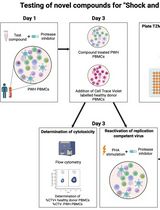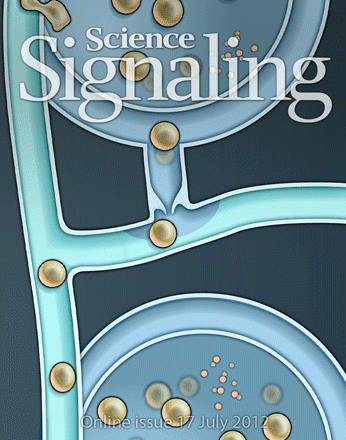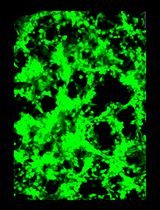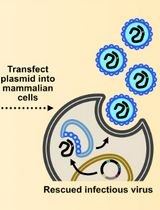- EN - English
- CN - 中文
Quantification of Infectious Sendai Virus Using Plaque Assay
利用空斑实验量化分析传染性仙台病毒
发布: 2018年11月05日第8卷第21期 DOI: 10.21769/BioProtoc.3068 浏览次数: 7790
评审: Longping Victor TseWelsch Charles JeremyAnonymous reviewer(s)

相关实验方案

诱导型HIV-1库削减检测(HIVRRA):用于评估外周血单个核细胞中HIV-1潜伏库清除策略毒性与效力的快速敏感方法
Jade Jansen [...] Neeltje A. Kootstra
2025年07月20日 2393 阅读
Abstract
Sendai virus (SeV) is an enveloped, single-stranded RNA virus of the family Paramyxoviridae. SeV is a useful tool to study its infectious pathomechanism in immunology and the pathomechanism of a murine model of IgA nephropathy. Virus quantification is essential not only to determine the original viral titers for an appropriate application, but also to measure the viral titers in samples from the harvests from experiments. There are mainly a couple of units/titers for Sendai viral quantification: plaque-forming units (PFU) and hemagglutination (HA) titer. Of these, we here describe a protocol for Sendai virus plaque assay to provide PFU using LLC-MK2 cells (a rhesus monkey kidney cell lines) and Guinea pig red blood cells. This traditional protocol enables us to determine Sendai virus PFU in viral stock as well as samples from your experiments.
Keywords: Sendai virus (仙台病毒)Background
SeV is a mouse parainfluenza virus type I (Faisca and Desmecht, 2007) that was discovered in Sendai, Japan, in the 1950s (Ishida and Homma, 1978). SeV is a useful tool to study its infection and immune reaction (Fensterl et al., 2008; Chattopadhyay et al., 2010, 2011 and 2013; Yamashita et al., 2012a, 2012b and 2013; Veleeparambil et al., 2018) and the pathomechanism of a SeV-induced of IgA nephropathy (Yamashita et al., 2007; Chintalacharuvu et al., 2008). SeV is Precise viral quantification is essential to perform animal and cell culture experiments using an appropriate dose of SeV and also to obtain correct results from experimental samples containing SeV. In 1970s, SeV was quantitated by inoculation into embryonated eggs using hemagglutinin production as a criterion for infection (Shibuta et al., 1971). This method is highly sensitive but time consuming and complex. Therefore, a kidney cell-based plaque assay, a simple and reliable assay using hemadsorption (the attachment of red blood cells to the surface of cell monolayers infected with virus) has been developed (Jessen et al., 1987). This protocol provides a method for SeV PFU using LLC-MK2 cells (a rhesus monkey kidney cell lines) and Guinea pig red blood cells. This method can be applied for most types of samples including cell culture media, cell lysates, tissue homogenates, serum, urine, and bronchoalveolar lavage.
Materials and Reagents
- 96-well Polypropylene 1.2 ml Cluster Tubes (Sigma-Aldrich, catalog number: CLS4401-960EA)
- CorningTM 6-well plate (Thermo Fisher Scientific, catalog number: 07-200-83)
- CorningTM 10 ml pipettes (Thermo Fisher Scientific, catalog number: 07-200-574)
- 15 ml tubes (Thermo Fisher Scientific, catalog number: 12-565-268)
- Sendai virus (ATCC, catalog number: ATCC VR-105) as positive control
- HyClone® Characterized Fetal Bovine Serum, U.S. Origin (GE Healthcare Life Sciences, catalog number: SH30071.03HI)
- GibcoTM Gentamicin, 10 mg/ml (Thermo Fisher Scientific, catalog number: 11500506)
- L-Glutamine, 200 mM (Thermo Fisher Scientific, catalog number: A2916801)
- LLC-MK2 Original (ATCC, catalog number: CCL-7)
Note: These cells are maintained in Medium 199 (Thermo Fisher Scientific, catalog number: 11150-067) containing 5% Fetal Bovine Serum, 20 μg/ml gentamicin, and 2 mM L-glutamine (complete Medium 199). LLC-MK2 cells should be used only up to about passage of 50. The plaques will become gradually smaller as the cell line ages. - Guinea Pig Blood in Alsevers (Rockland antibodies & assays, catalog number: R305-0050)
Note: This needs to be less than 2 weeks old. - Medium 199 (10x) (Thermo Fisher Scientific, catalog number: 11825015)
- Medium 199 (1x) (Thermo Fisher Scientific, catalog number: 11150067)
- HBSS, calcium, magnesium (Thermo Fisher Scientific, catalog number: 14025092)
- Sodium Bicarbonate 7.5% solution (Thermo Fisher Scientific, catalog number: 25080094)
- BD Difco Agar (Fisher Scientific, catalog number: DF0812-17-9)
- Trypsin (0.25%), phenol red (Thermo Fisher Scientific, catalog number: 15050065)
Note: The final concentration is 0.00025% (2.5 μg/ml). This reagent needs optimization for a particular lot. 2.5 μg/ml ± 0.25 μg/ml can make the difference between nice large plaques and the cells detached from the plates. - Sterile PBS (with Ca2+ and Mg2+)
- Penicillin-Streptomycin (5,000 U/ml) (Thermo Fisher Scientific, catalog number: 15070063)
- Complete 2x medium (see Recipes)
Equipment
- Multichannel pipette (Gilson, catalog number: FA10015)
- Pipettes, P20, P200, P1000 (Gilson, catalog number: F167300)
- Biosafety cabinet (Thermo Fisher Scientific, catalog number: 1305)
- Tissue culture incubator (at 37 °C with 5% CO2) (Thermo Fisher Scientific, catalog number: 51025983)
- 100 ml glass bottles (Research Products International, catalog number: 219510)
- PrecisionTM General Purpose Water bath (Thermo Fisher Scientific, catalog number: TSGP02)
- Autoclave (Steris Amsco Eagle, catalog number: 3021-C Gravity Steam Sterilizer)
- Sonic water bath (Skymen Cleaning Equipment, model: JP-008)
- Vortex mixer (Research Products International, catalog number: 155560)
- Portable Mini Light Box, Benchtop Light Source (Research Products International, catalog number: 815500)
Procedure
文章信息
版权信息
© 2018 The Authors; exclusive licensee Bio-protocol LLC.
如何引用
Tatsumoto, N., Miyauchi, T., Arditi, M. and Yamashita, M. (2018). Quantification of Infectious Sendai Virus Using Plaque Assay. Bio-protocol 8(21): e3068. DOI: 10.21769/BioProtoc.3068.
分类
微生物学 > 微生物-宿主相互作用 > 病毒
您对这篇实验方法有问题吗?
在此处发布您的问题,我们将邀请本文作者来回答。同时,我们会将您的问题发布到Bio-protocol Exchange,以便寻求社区成员的帮助。
Share
Bluesky
X
Copy link











